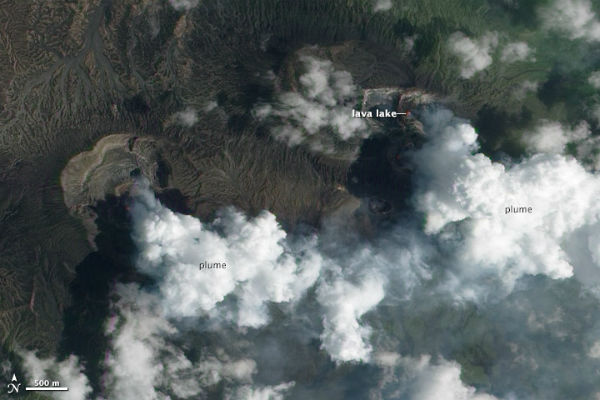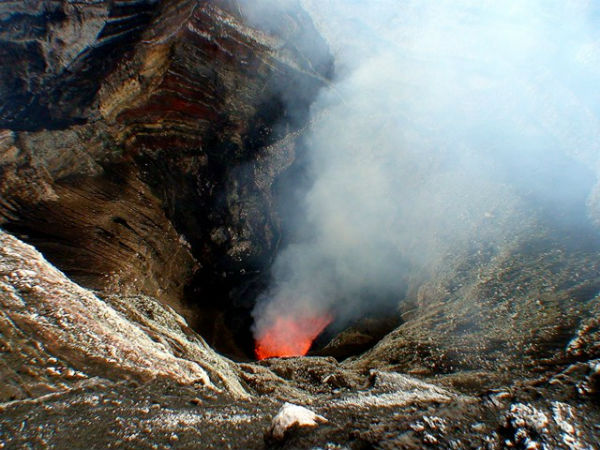

| Visitors Now: | |
| Total Visits: | |
| Total Stories: |
Ambrym’s twin lava lakes captured by satellite
Vanuatu’s Ambrym volcano with its roiling pools of lava glow a deep orange, spewing fountains of lava and seemingly endless plumes of steam and gas. The Advanced Land Imager (ALI) aboard the Earth Observing-1 (EO-1) satellite captured twin lava lakes on Ambrym’s Marum cone on December 13, 2012. are visible. The larger of the two, which is gray, lies within Mbuelesu crater (to the southwest) while Mbuelesu has a secondary crater that contains a pinkish-gray lava lake. Active lava lakes often have a partly solid, shiny gray crust that forms as the atmosphere cools their surfaces. The crust is rarely more than 5 to 30 centimeters (2 to 12 inches) thick and usually lasts just a few hours because it continually circulates, breaks, and sinks into the molten lava below. The surface of smaller lake was especially agitated and the crust was absent or in the process of sinking back into the lake.

The Advanced Land Imager (ALI) aboard the Earth Observing-1 (EO-1) satellite captured this natural-color image of activity within Ambrym’s caldera on December 13, 2012. (NASA Earth Observatory image by Robert Simmon, using EO-1 ALI data from the NASA EO-1 team and USGS Global Visualization Viewer. Caption by Adam Voiland)
Ambrym, one of the most active volcanoes in the world, is a large basaltic volcano with a caldera that is about 12 kilometers (7 miles) wide. The most active vents of more than 2000 years old Ambrym are Marum and Benbow which have been roiling for the past 300 years.
The caldera was formed during a major plinian eruption with dacitic pyroclastic flows about 1900 years ago. Post-caldera eruptions, primarily from Marum and Benbow cones, have partially filled the caldera floor and produced lava flows that ponded on the caldera floor or overflowed through gaps in the caldera rim. Post-caldera eruptions have also formed a series of scoria cones and maars along a fissure system oriented ENE-WSW. Eruptions have apparently occurred almost yearly during historical time from cones within the caldera or from flank vents. However, from 1850 to 1950, reporting was mostly limited to extra-caldera eruptions that would have affected local populations.

A lava lake is visible inside Mbuelesu crater within Marum cone at Ambrym on June 7, 2007. Lava lake activity was observed during a field expedition from May to June. MODIS thermal alerts had resumed at Ambrym since November, 2006, and ash eruptions took place in April and March, 2007.
(Credit: Steven Clegg/GVP)
Source: Earth Observatory, The Smithsonian’s Global Volcanism Program
Ambrym’s twin lava lakes captured by satellite
2012-12-22 23:34:26
Source: http://thewatchers.adorraeli.com/2012/12/19/ambryms-twin-lava-lakes-captured-by-satellite/
Source:



